Meet Mike Bohn, the man tasked with resurrecting USC football with one perfect hire
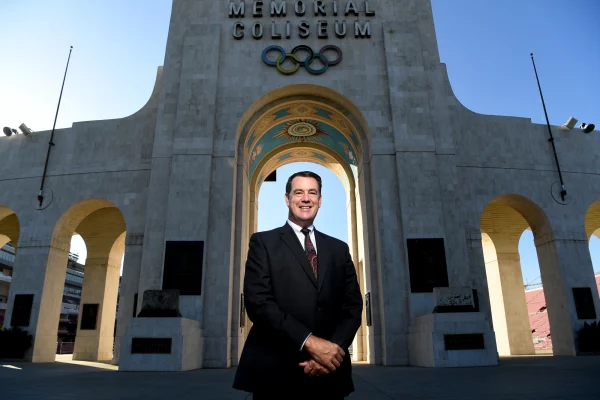 Ryan Kartje (LA Times, very long article) — Six hundred and fifty-one days of unrest and uncertainty dragged on as Mike Bohn awaited this September morning. During the worst of the pandemic, when the seclusion weighed most on his soul, Bohn longed for the simplicity of the scene that now unfurled before him. USC’s athletic director stood amid a sea of cardinal and gold buzzing with life. Classic rock pouring out from tailgate tents. Fans flooding the Coliseum’s south lawn, toasting their reunions with red Solo cups.
Ryan Kartje (LA Times, very long article) — Six hundred and fifty-one days of unrest and uncertainty dragged on as Mike Bohn awaited this September morning. During the worst of the pandemic, when the seclusion weighed most on his soul, Bohn longed for the simplicity of the scene that now unfurled before him. USC’s athletic director stood amid a sea of cardinal and gold buzzing with life. Classic rock pouring out from tailgate tents. Fans flooding the Coliseum’s south lawn, toasting their reunions with red Solo cups.
Those reunions couldn’t have come soon enough. Bohn, by his own admission, was ill-suited for isolation. The blustery passion that had come to define his climb through college athletics was not meant to be confined to Zoom calls. The distance left him drained, disconnected from the very department he was tasked with rebuilding. “We’re supposed to be in the people business,” he lamented in September 2020. So how exactly, Bohn wondered, was someone expected to restore faith in the Trojans while working remotely?
After a grueling year, Bohn stood in the shadow of the Coliseum on the first Saturday of the 2021 season. He’d spent nearly 90% of his USC tenure operating at a distance. Brandon Sosna, his chief of staff, had done the math. “It’s depressing just to hear that,” Bohn said.
It was a difficult time to be an athletic director, juggling health mandates, testing protocols and other issues beyond his job description. But this part — the selfies and the fist bumps — had always come naturally. Each interaction seemed to energize Bohn. Every few steps, he was compelled again to stop, introducing himself to anyone offering even the briefest glint of eye contact.
“Hi, my name is Mike Bohn,” he said. “I’m the new athletic director.”
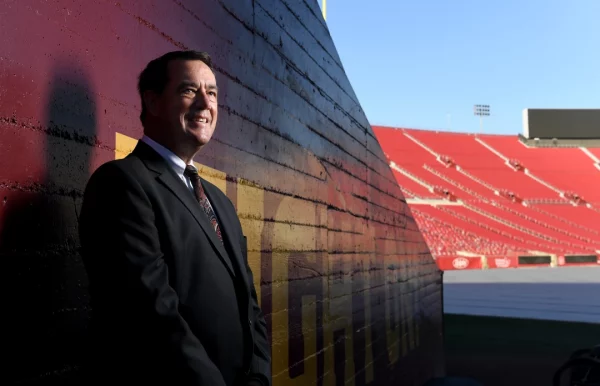 USC athletic director Mike Bohn was eager to finally welcome fans back to the Coliseum as he works to restore faith in the program.
USC athletic director Mike Bohn was eager to finally welcome fans back to the Coliseum as he works to restore faith in the program.
(Wally Skalij / LAT)
Never mind that it’d been nearly two years since Bohn took over at USC — not all that much longer than Lynn Swann, the previous athletic director, served in the post. Bohn spent much of that time cleaning up messes his predecessors left behind, rebuilding a department not only rocked by scandal but plagued by a decade of insularity and stagnation.
He’d made major strides considering the circumstances. But at the start of a new season, he couldn’t shake the feeling he hadn’t accomplished enough. He still hadn’t quite settled into his role.
“Clearly,” Bohn said, “we have a lot of work to do here still.”
The most pressing work had yet to begin. Nine days later, Bohn fired Clay Helton two games into his seventh season, cutting the cord on a football coach Bohn twice elected to retain despite consistent public outcry for his ouster.
Many wondered why he waited so long. Had Bohn fired Helton in 2019, when he first weighed the coach’s future, he might’ve instantly endeared himself to a fanbase whose frustrations had already reached a fever pitch. There were other considerations, of course; namely a pricey buyout believed to be around $20 million. But even USC administrators in his own department acknowledge Bohn’s job would’ve been simpler if he had immediately cut ties with Helton.
Instead, Bohn decided on a different direction, irritating fans by focusing on rebuilding and reinvesting in a program that, for years, had done little of either. It was a tough sell to those who long ago lost trust in USC. But as Bohn and Sosna saw it, even the best of football coaches would be doomed to fail with the barebones infrastructure they inherited.
Every decision since has been made with that vision in mind, setting the table for a search that not only will define Bohn’s tenure, but determine the direction of USC football for years to come. For all the progress he’s made elsewhere, it’s not lost on Bohn that the football coach he hires will color every evaluation of his job — fair or not.
Those who have witnessed Bohn’s climb through college athletics suggest it’s a weight he’s uniquely qualified to carry. They point to the obstacles he inherited elsewhere, from Idaho to San Diego to Colorado to Cincinnati. Within his own department at USC, there’s sincere hope Bohn will be the one to finally guide Trojans football back to championships.
Watch Bohn work a crowd, and you’ll start to understand where that faith comes from. Ahead of USC’s season opener, he’s a one-man pep rally: stopping to chat with recruits, starting a chant with students, thanking ticket-takers, security staff and even the in-house DJ. “This is the most talented guy in America!” he declares to anyone within earshot. With each impassioned introduction, walls come down. Eyes light up.
He may not win over an entire fanbase, one person at a time, but he seems content to try.
“Why wouldn’t you?” Bohn asks. “It’s not that hard!”
Of course, it could all be for naught if the next coach can’t deliver. But as he sells the USC community on his vision, his approach could not stand in starker contrast to his predecessors.
It was just a few hours before tipoff in February 2020, a few precious weeks before the pandemic thrust college sports into crisis, as Bohn led a reporter through the mostly vacant offices at Galen Center with only the vaguest idea of where he was supposed to be.
But no one gets lost quite so enthusiastically. Bohn was trying random office doors and greeting any employees who cross his path. “Hey! Thanks for being here!” he said to one. “Great to see you!” he told another. Exclamation points flow liberally with USC’s athletic director, who before long had taken up the role of tour guide through a still-unfamiliar office, regarding each detail of his new domain with wide-eyed wonder.
Bohn was just finding his bearings, settling into a role that since 1993 had been held solely by Trojan football heroes. As an outsider, his first three months on the job had been a rude awakening as he discovered the depth of the department’s issues. The university was reeling from the Varsity Blues scandal, as well as the FBI investigation that saw a USC men’s basketball assistant indicted on bribery charges. The scandals were symptoms of deeper problems within an organization that often resisted change.
“He inherited an athletic department that needed a lot of help,” said Rick Caruso, the chair of USC’s board of trustees. “This was an organization that was very wounded, very conflicted, had been hit with these scandals and you had to go in and completely rebuild it. That’s a heavy load. It’s like that old saying, repairing an airplane while it’s still flying.”
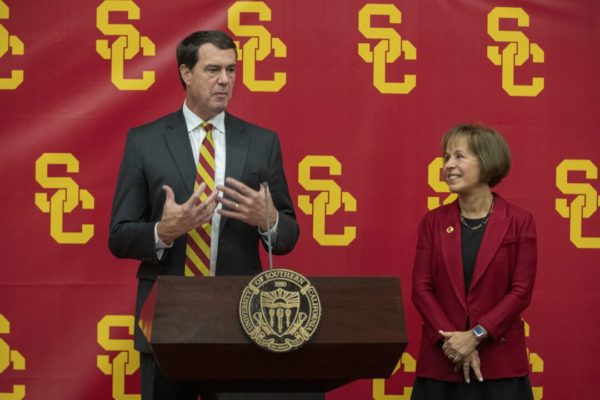
USC AD Mike Bohn speaks while USC President Carol L. Folt looks on Nov. 7, 2019. (Brian van der Brug / LAT)
It didn’t help that the previous pilot had no experience flying a plane. Like Pat Haden before him, Swann had never been a college administrator when he was hired as USC’s athletic director in 2016. Even as the football team enjoyed an improbable Rose Bowl run that first season, few in the department were surprised to find Swann was completely out of his depth leading a $120-million operation. Times reporting in 2019 would later show that his sudden candidacy stemmed primarily from the influence of a single USC mega-donor.
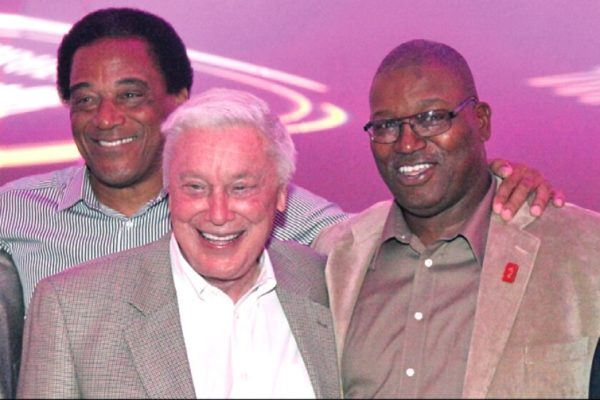 This secret donor has given USC $400 million
This secret donor has given USC $400 million
So they set off in their own directions. Siloes formed, and communication suffered. Long-vacant roles went unfilled, piling up work for some and further deepening divides among others. Out of the disrepair, scandal grew like weeds.
Swann, meanwhile, was rarely present within the department. Current and former employees not authorized to speak with media about the inner workings of the athletic department that is still subject to Varsity Blues litigation say he spent most of his time preoccupied with the football program — at one point, inking Helton to an albatross of an extension in 2017 — while showing little to no interest in any of USC’s women’s sports teams. When there was a conflict, an administrator said, Swann often used silence as his preferred method of problem-solving, leaving staff wondering what he was thinking but unable to move forward.
An uncomfortable cloud of uncertainty settled over the department in the wake of the Varsity Blues scandal, and Swann offered little leadership or reassurance, telling The Times in March 2019 he was “blindsided” by the scandal. Two weeks later, as university leaders gathered at a Santa Barbara retreat to discuss the fallout, Swann was at a paid appearance in Virginia, signing memorabilia during an autograph show.
He’d last six more months in the job, but a person familiar with the president’s decision who was not authorized to speak with the media amid pending Varsity Blues litigation told The Times his resignation was set into motion long before that.
Bohn knew he would face formidable obstacles when he was offered the job in the fall of 2019. He weighed the potential pitfalls with mentors and family members, but the challenges, as he saw them, were part of the attraction.
“It’s cliché, but there are no utopias,” Bohn said. “Very rarely is a marquee job open because things are going really well.”
Kent Smith, his high school basketball coach, told Bohn rebuilding USC could be “his crowning achievement.” The notion stuck with him.
Still, there were some reservations about him leaving Cincinnati, where everything seemed to finally be falling into place. He’d hired Luke Fickell as football coach and helped facilitate major facility improvements, all with the intent of putting Cincinnati in place to move up to the Power Five.
His daughter, Miki Tynan, worried about the scrutiny that came with the USC job. She laid out her concerns to Bohn, whose mind, she said, was already made up.
“He just told me, ‘I want to do this,’” Tynan said. “‘I feel like I’ve reached the peak of what I can do at Cincinnati. I’m ready for this. I want this challenge. I know what USC is capable of.’”
“It was refreshing,” Caruso said. “We had not had a professional athletic director in quite some time.”
For Bohn, college athletics was all he’d ever known. He grew up in Boulder, Colo., idolizing Buffaloes stars such as Cliff Branch and Bobby Anderson. After barely playing as a backup quarterback at Kansas, his career began in the marketing office at the Air Force Academy in 1984, where he often moonlighted as basketball public address announcer. He left after eight years for the College Football Assn., where Chuck Neinas, a former Big Eight commissioner, could sense his young marketing director had a bright future ahead.
“He could sell you without trying to sell you,” Neinas said. “He was a natural.”
It would serve him well as he rose through the ranks. Bohn was just 37 when he took the reins at Idaho in the midst of a massive effort to move up to the Division I-A level in football. The department was starved for cash, leaving Bohn with a $1-million deficit to balance. Negotiations were still ongoing for Idaho to play four home games at Washington State’s Martin Stadium to help Idaho meet the NCAA’s average attendance requirement. The risk of falling short was significant. Everyone in the department felt the pressure.
“It was a heavy lift,” said Texas El Paso athletic director Jim Senter, a close friend who worked with Bohn at Idaho and two other stops.
It meant working tirelessly to sell tickets. Senter recalled the two of them making stops all over Idaho, giving away free Idaho polos with the purchase of $60 season passes. At each stop, Bohn would set out to convince wary Idahoans of their responsibility to support the Vandals, who at that point were expected to be the worst football team in Division I-A.
Not even the eternally optimistic Bohn could’ve envisioned how that season would unfold, as Idaho won nine games out of nowhere, including the 1998 Humanitarian Bowl. He still considers the ring from the Vandals’ unexpected bowl win to be one of his prized possessions.
Bohn turned the momentum into a $13-million facility upgrade. But the hope — and the funds — conjured from that season soon ran into a brick wall.
The challenges were just beginning. Idaho’s coach left for Nevada after the 1999 season. The Big West stopped playing football in 2000 and Idaho was passed over by the Western Athletic Conference, leaving the Vandals to join the far-flung Sun Belt. Facing questions about whether Idaho should stay in Division I-A, Bohn remained steadfast. But Idaho won just three of its next 28 games before Bohn left for San Diego, where new challenges awaited.
Each new stop followed a similar pattern, as Bohn stepped into increasingly tumultuous circumstances. At San Diego State, Bohn took over a department beset by scandal after a Cal State audit found major mismanagement in the department, unveiling a scheme in the equipment room that cost three top administrators their jobs, inspired two lawsuits, and left the football program on probation.
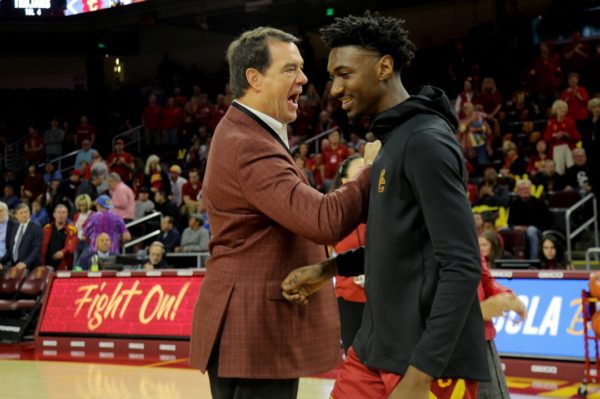
USC AD Mike Bohn congratulates guard Jonah Mathews during a senior recognition ceremony before a game against UCLA at Galen Center on March 7, 2020.
(Gina Ferazzi / LAT)
The fallout of another major scandal awaited at Colorado, where numerous allegations of sexual assault and impropriety within the football program had left the department in serious turmoil, faced with fundraising shortfalls and a multimillion-dollar deficit.
Bohn likened the two situations to “stepping into a hornet’s nest.” In San Diego, Bohn met with student groups to sell them on a fee initiative and canvassed the community in search of major donors. The infusion of energy made a noticeable impact: The Aztecs won four games that first football season, but saw the third-largest attendance increase of any team at the Football Bowl Subdivision level. A swath of new top donors helped erase the deficit.
When he left for Colorado, the program Bohn grew up cheering for was in deep trouble. Trust was shaken. Thousands of season tickets went unrenewed in the aftermath of a Title IX and recruiting scandal, the football coach was under fire, and fundraising was in shambles. So Bohn set out to unify, peddling hope as he had in Idaho and San Diego, driving around with a pile of Buffs T-shirts in the trunk and a CD with the Colorado fight song always at the ready. Gail Pederson, who served as his Colorado chief of staff, recalled several occasions in which he drove across town to hand-deliver season tickets. Neinas remembers Bohn once directing traffic during a snowstorm after a basketball game.
Bohn tried to set a similar tone in the department. One of his first acts as Colorado athletic director in 2005 was to change the large wooden doors of his office to glass to encourage visitors. A large sign depicting the department’s new guiding principles was hung prominently in the office.
“People grew to understand that his enthusiasm, his energy — it was real,” Pederson said.
Even then, it would take Bohn only so far at Colorado.
At USC, he’d inherit another deeply damaged department. Two months after his arrival, he forced out three senior athletics officials, including longtime chief financial officer Steve Lopes, leaving some in the department frustrated.
Trust was tenuous, at first. Bohn’s relentless enthusiasm represented a major shift in tone.
“Morale was pretty low,” explained Paul Perrier, USC’s executive senior associate athletic director. “Whenever you get a new leader, there are all kinds of different emotions — skepticism, concern. But Mike kept showing up. He kept showing it wasn’t about him, but the department as a whole.”
Bohn filled his schedule those first few months at USC with meeting after meeting, asking students, coaches, employees, administrators — anyone in his orbit, really — how he could help. Todd Hewitt, USC’s former director of equipment operations, said Bohn went so far as to ask two of his staffers tasked with washing football uniforms how he could improve the laundry.
The requests were often surprisingly reasonable: A $400 device to help move the lacrosse goals for the women’s team. Saturday night dinners for the baseball team. Others, Bohn couldn’t believe had gone unheard: For years, USC leaders had refused to update their football headsets to CoachComm, the industry standard used by 97% of Football Bowl Subdivision programs. Instead, USC football subsisted through the 2019 season with an out-of-date setup that left coaches at risk of suddenly switching frequencies in the middle of games.
Bohn spent most of those initial meetings handing out apologies. But as the pandemic struck in March and college athletics was thrust into chaos, USC administrators would whisper among themselves how fortunate they were that it was Bohn, not Swann, guiding USC through the pandemic.
He was still building confidence Februarys ago, when Bohn ducked suddenly into a Galen Center office, where sales reps were still taking calls.
These were the frontlines for frustrations about USC football, which is to say, since Helton was retained, it’d been a dark couple months working the phones. But as Bohn slipped into a booming soliloquy, declaring his profound appreciation for their existence with no regard for volume, the energy in the room changed. The sales reps looked from their desks, smiling awkwardly, unsure of how to react to a sudden drop-in by the head of the department.
“You’re doing a great job!” Bohn said, shaking their hands.
“See how much of a difference it makes, just showing up?”
Sosna arrived just in time to refocus Bohn’s energy on the dozen or so donors waiting to hear from him down the hall. Soon, Bohn took his place at the front of the room, ready to perform again.
“Did you hear the story the other day …?” he starts.
By the punch line, five minutes later, the crowd of donors was putty in his hands.
Bohn first learned to work a crowd in the bleachers of Colorado’s Folsom Field. He was just 12 years old, carrying four-by-four trays of Cokes up and down the concourse, catching every glimpse of Colorado football he could between sales.
His memory of those Saturdays is still crystal clear 50 years later. He describes the refreshment stand in full detail, sparking one story … which sparks another.
He holds tight to the nostalgia these days. In the basement of his Manhattan Beach home, memorabilia lines the walls and shelves. Here’s a bat signed by Tony Gwynn. The basketball from Boulder High’s 1979 state championship. Helmets and posters and trophies from every period of his life.
“It all inspires me,” he says. Each piece has its own story, and as he offered a tour last September, he’s happy to share a few.
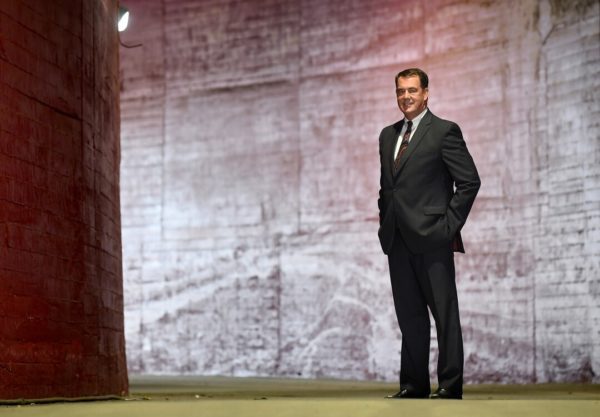
Mike Bohn stands in the tunnel of the Coliseum. (Wally Skalij / LAT)
The middle son of three boys, Bohn was raised mostly by his mother, Marlyn, a feisty physical education teacher, who became the first female state Little League baseball director west of the Mississippi. His father was a traveling salesman, but his parents divorced when he was in middle school. Money was tight, so the Bohns held garage sales to get by.
The family settled in an idyllic corner of North Boulder, two houses down from Mike’s best friend, Steve Jouard. The two young boys were too preoccupied with sports to pay attention to much else, most nights playing basketball or Wiffle ball until it was too dark to see.
The practice paid off. Bohn became a three-sports star at Boulder High, where he met his wife, Kim. As he climbed the ladder in college sports, he dreamed of them returning home to Boulder someday.
He finally got that chance in 2005, with Colorado in major turmoil.
“Being the local boy, who won the state championship, he was on stage 24/7,” Neinas said. “It was a tough job.”
During eight years, he set out to repair the image of the department, guiding Colorado out of a period of turmoil. He nearly doubled the operating budget. He built back the men’s basketball program, hiring current coach Tad Boyle and setting home attendance records. He also ushered the Buffaloes through conference realignment and into the Pac-12.
But his experience hiring football coaches was far less successful. After inheriting embattled coach Gary Barnett, Bohn forced him out in 2005. In his place, he hired Boise State’s Dan Hawkins, who was considered one of the hottest candidates in college football. Bohn, at the time, called him “a home run hire.” But Hawkins flamed out as coach, going 19-39 in five seasons.
Next, Bohn hired Jon Embree, an alum and NFL assistant meant to harken back to Colorado football’s glory days. But there was nothing glorious about his brief tenure. Embree went 4-21 in two seasons before he was fired, too, leaving with a scathing, tearful news conference that included a rebuke of Bohn.
Mike MacIntyre knew Colorado was one of the worst football teams in the BCS when he took the job in December 2012. But it was Bohn, he says now, who convinced the coach that changes were imminent. He laid out plans for the program in a booklet, organized from A to Z, and gave it to MacIntyre. Many of those plans, the coach recalled, eventually came to fruition.
“I believed in him and his enthusiasm,” said MacIntyre, who went 30-44 at Colorado. “He was from Boulder. He loved everything about that place.”
MacIntyre accepted the job, only for Bohn to be forced out six months later.
The decision, passed down by the university chancellor, shook Bohn to his core. He was blindsided.
“It was very traumatic for him,” Marlyn Bohn recalled. “He’d never lost anything like that before.”
Two days after the decision was announced, Bohn stood in front of gathered reporters at a hotel, determined to set the record straight. Leaked internal documents would later show Colorado officials expected Bohn to stick to the company line, sending him talking points that portrayed the decision as “a mutual conclusion.”
But Bohn went off book in his own press conference. “I had no idea this was coming,” he said. He read from a seven-page packet he’d compiled listing his accomplishments as athletic director. He fired back against implications from university leadership that fundraising had led to his ouster.
“I met virtually every expectation of all my incentives for eight years straight,” Bohn said. “I gave it my all.”
The exit prompted months of soul searching. “I was a little naive then,” he says now. But in the failure were lessons Bohn would carry with him to USC.
“I can’t give you a recipe for success,” Bohn said. “But I can guarantee you one for failure, and that’s trying to be everything to everyone.”
It made for a contentious introduction. But for two years, as fan frustrations festered, Bohn set about reimagining the entire operation, building a sound infrastructure around USC’s coach, beefing up support staff and reinvesting in recruiting. When he finally fired Helton, after a humiliating defeat to Stanford almost two years later, Bohn said the time had been well spent.
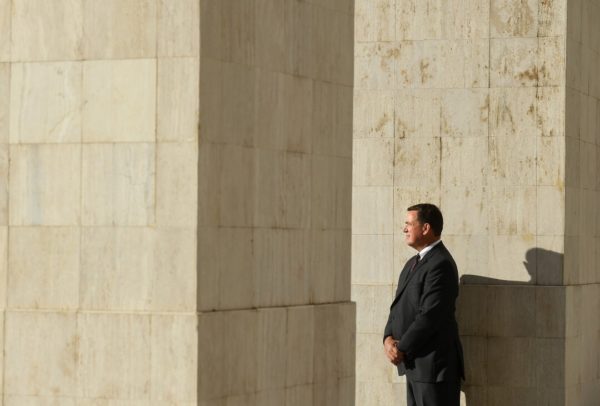 Mike Bohn is focused on hiring a football coach capable of turning around USC. (Wally Skalij / LAT)
Mike Bohn is focused on hiring a football coach capable of turning around USC. (Wally Skalij / LAT)
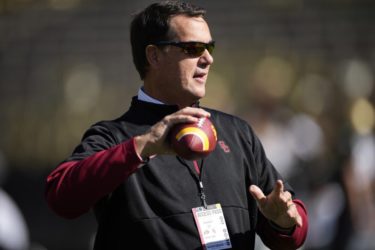
Hopefully Bohn won’t pull a “bohner” on the next Head Football Coach!
To make a very long story short. When Folt and Bohn took over, the Athletic Department was in the crapper like the rest of the university. They needed to rebuild an administration “plagued by a decade of insularity and stagnation”. 2 years ago no first rate head coach was going to come work in a mismanaged Athletic Department. Now they will and be excited to resurrect the sleeping giant.
Golden, The reason is irrelevant; SC was not prepared in 2019 to replace Clay. It was prepared to do so in 2021. I really think we will get a huge upgrade over Clay. Let’s see who it is!
Kenan Christon fighting his USC suspension (for escalating an altercation with another USC student who contacted his girlfriend), accuses school of unfair treatment:
latimes.com
A young man getting into a tussle with another young man over a girl. Minor tussle in which no one was hurt. And he gets suspended for two years? The “black advocate is a mistake. SC is not bias against young men of color. It is biased against males. If two females has a tussle over a male, I doubt the result would have been the same.